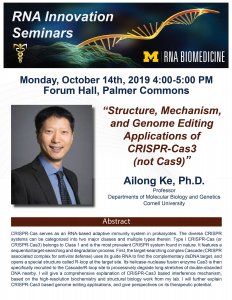Presented By: Center for RNA Biomedicine
RNA Innovation Seminar, Ailong Ke, Cornell University
"Structure, Mechanism, and Genome Editing Applications of CRISPR-Cas3 (not Cas9)"

Ailong Ke PhD, Professor, Department of Molecular Biology and Genetics, Cornell University
Abstract: CRISPR-Cas serves as an RNA-based adaptive immunity system in prokaryotes. The diverse CRISPR systems can be categorized into two major classes and multiple types therein. Type I CRISPR-Cas (or CRISPR-Cas3) belongs to Class 1 and is the most prevalent CRISPR system found in nature. It features a sequential target-searching and degradation process. First, the target-searching complex Cascade (CRISPR associated complex for antiviral defense) uses its guide RNA to find the complementary dsDNA target, and opens a special structure called R-loop at the target site. Its helicase-nuclease fusion enzyme Cas3 is then specifically recruited to the Cascade/R-loop site to processively degrade long-stretches of double-stranded DNA nearby. I will give a comprehensive explanation of CRISPR-Cas3 based interference mechanism, based on the high-resolution biochemistry and structural biology work from my lab. I will further explain CRISPR-Cas3 based genome editing applications, and give perspectives on its therapeutic potential.
Abstract: CRISPR-Cas serves as an RNA-based adaptive immunity system in prokaryotes. The diverse CRISPR systems can be categorized into two major classes and multiple types therein. Type I CRISPR-Cas (or CRISPR-Cas3) belongs to Class 1 and is the most prevalent CRISPR system found in nature. It features a sequential target-searching and degradation process. First, the target-searching complex Cascade (CRISPR associated complex for antiviral defense) uses its guide RNA to find the complementary dsDNA target, and opens a special structure called R-loop at the target site. Its helicase-nuclease fusion enzyme Cas3 is then specifically recruited to the Cascade/R-loop site to processively degrade long-stretches of double-stranded DNA nearby. I will give a comprehensive explanation of CRISPR-Cas3 based interference mechanism, based on the high-resolution biochemistry and structural biology work from my lab. I will further explain CRISPR-Cas3 based genome editing applications, and give perspectives on its therapeutic potential.